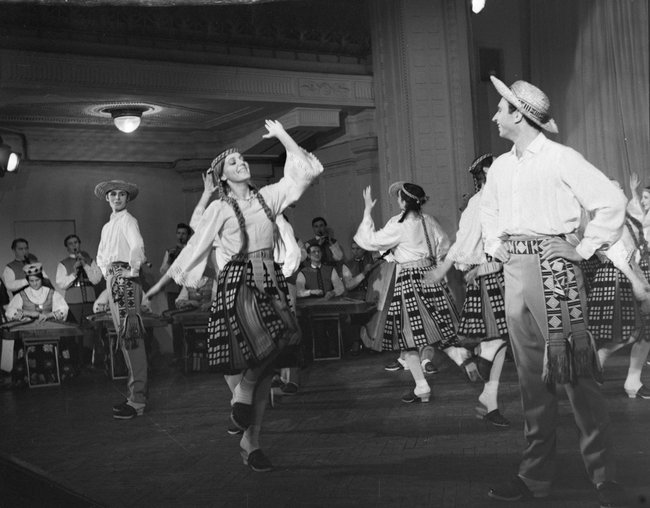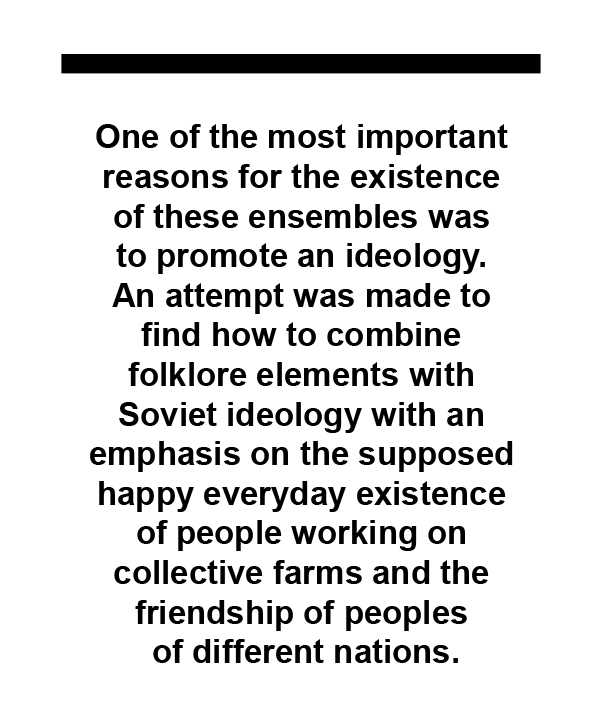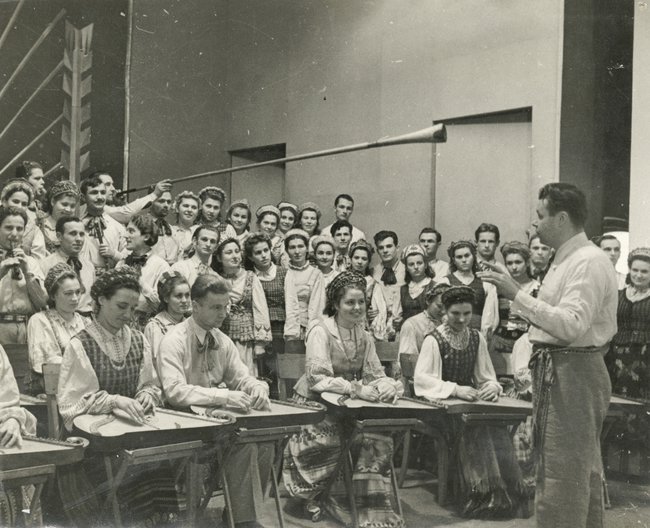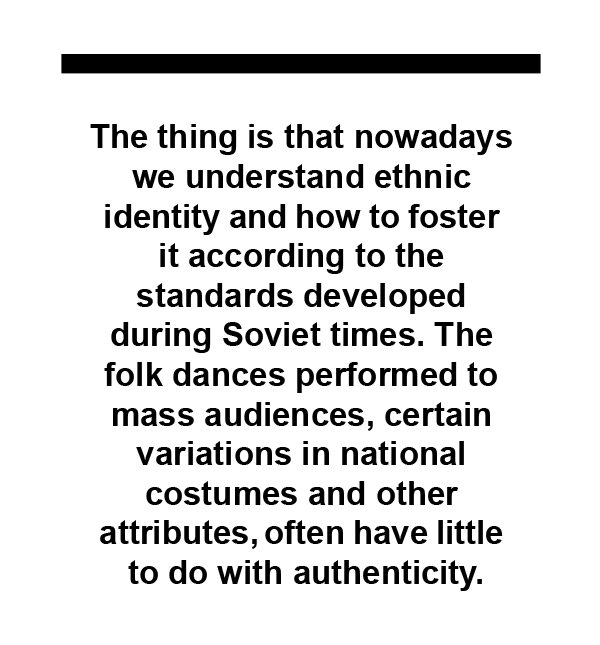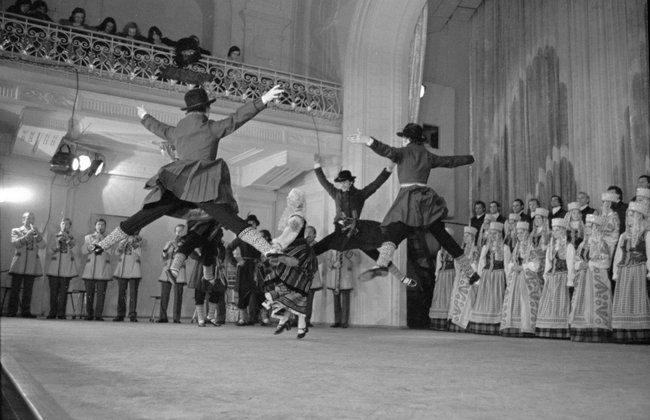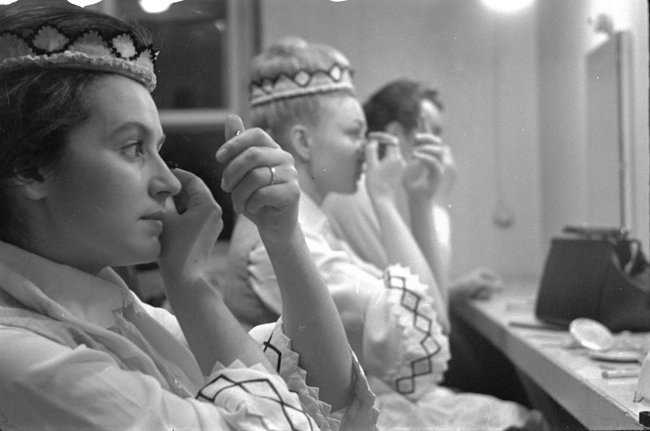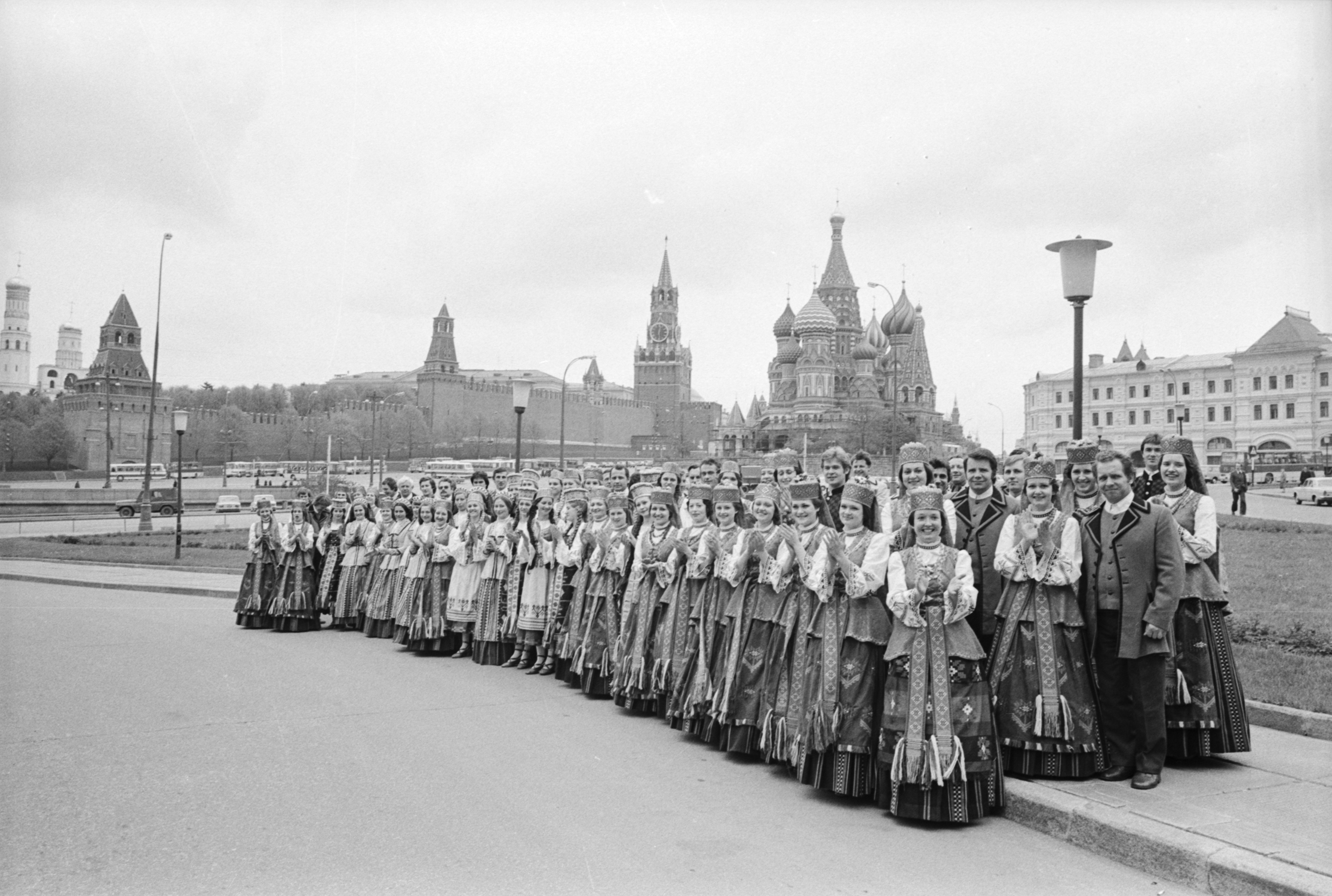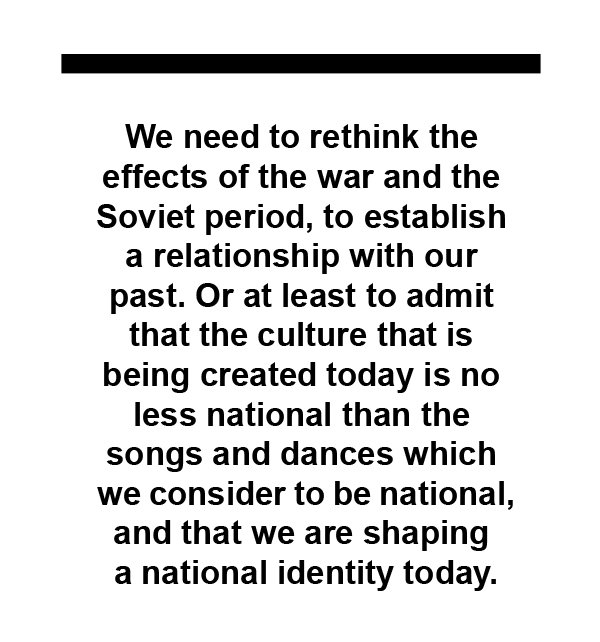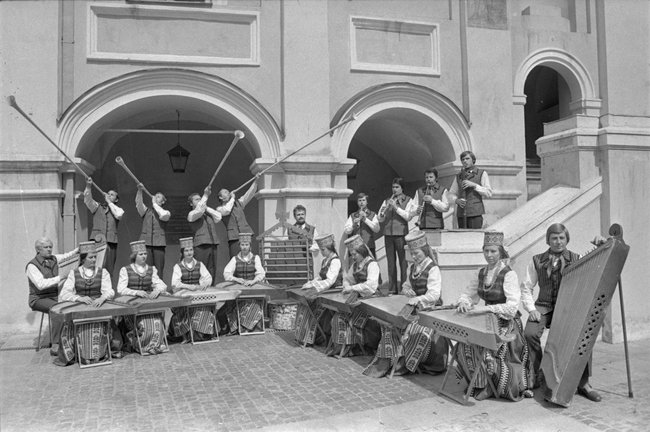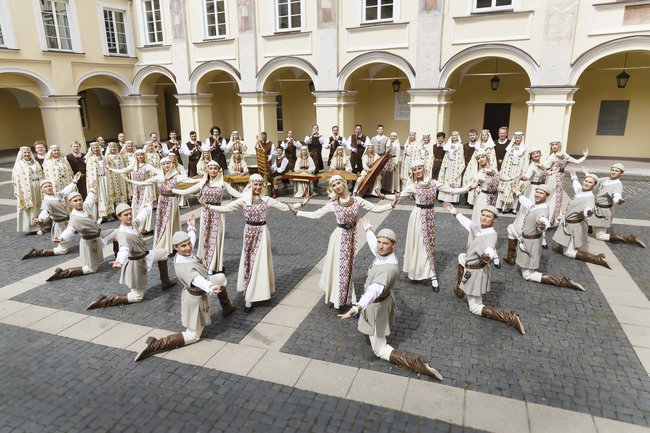Jūratė KATINAITĖ | Ballet in Clogs, Or to Whom Does National Art Belong? An Interview with the Philosopher Nerija Putinaitė
Coming to the end of the third decade of independence, Lithuania often feels too little removed from the Soviet era. It is a post-traumatic society for which it is difficult to heal because of failing to come to terms with the recent past. The Soviet period continues to haunt Lithuanian culture, values and thinking. One of the subjects requiring critical appraisal is what a national identity is in terms of the arts. What was the concept of national identity in the times of Lithuania’s independence during the interwar years (1918–1940), what was it like during the half-century of Soviet occupation, and how is it perceived now? In the newly restored Lithuania, new folklorism seems to be flourishing; world music enthusiasts are coming together, as well as postfolk groups that creatively combine the elements of the old folklore with various musical styles. There also exists the representative song and dance ensemble Lietuva (Lithuania) established during the Soviet period, fostering a then-created stylised folk art with the aim of being relevant to a contemporary audience. In spring 2019 Lietuva put on the mystery-play Gods and People, a show full of new technologies, after the premiere of which the philosopher Dr Nerija Putinaitė, one of the most preeminent critics of the culture of the Soviet era and the musicologist Jūratė Katinaitė, researcher into the music of the Soviet era and radio host, met for a discussion.
Jūratė Katinaitė: The Lietuva ensemble has been looking for a new identity and ways of fitting into the music market for over thirty years. How do you rate their efforts?
Nerija Putinaitė: The Lietuva ensemble (formerly The State Folk Song and Dance Ensemble) was established in imitation of the folk and song ensemble founded by the choreographer Igor Moiseyev in 1937 in Soviet Russia. The former leaders of Lietuva visited Moscow and studied the specifics of ‘folk-like’ choreography. The essence of this model was to choose elements of folklore and folk songs and refine them by using the classical forms of choreography and music so that the result would be folk art of a high artistic level. Similar ensembles were also active in other socialist countries.
One of the most important reasons for the existence of these ensembles was to promote an ideology. An attempt was made to find how to combine folklore elements with Soviet ideology with an emphasis on the supposed happy everyday existence of people working on collective farms and the friendship of peoples of different nations.
Another important thing was the professional mastery demanded of the performers. The pieces performed by these ensembles were so polished and of such technical complexity that only professional singers and ballet dancers were capable of performing them. This requirement has survived in the ensemble to this day.
If we were to raise the question of how the ensemble managed to survive after independence, we would have to look further afield and see how Soviet culture was carried over into a free Lithuania. After the restoration of independence, a lot of attention was placed on the reorganisation of governmental institutions and functions, while the cultural sector was largely overlooked. Basically, what remained was the organisational structure of (widely understood) culture: ensembles, the organisational centre of the song festivals and mass amateur activities in Vilnius and its branches in the regions, jobs for people responsible for organising those events, and so on. The original idea of the Lietuva ensemble as carrying representative function has survived to the present day.
Today the ensemble is looking for innovations, but the most important things have survived – elements of folklore in a refined form and the development of a certain kind of national folk ideology. It’s trying to adapt to a new ideological situation as well as to the use of new technologies. As a result, we have quite a strange mix – a seemingly modern spectacle but deeply Soviet in its structure and ideology.
The ensemble also stands out in the field of culture in that many of the groups similar to it exist on a project-competition principle whereas Lietuva has kept its representative status and enjoys support as a state ensemble. Many people perhaps don’t even know that the ensemble is still touring abroad and showing what is supposed to be a national culture.
How would you respond to critics who say that the ensemble is not just or in fact not at all representative of Soviet times? There are quite a few people from the world of culture – musicians, dancers, intellectuals and others – who claim that the ensemble promotes national culture. In 1940, in the same year, the Čiurlionis ensemble was also established which after the war was active in the American Lithuanian émigré community up to 1991. That ensemble also performed pieces created with their basis in folklore, but not developed to the same degree of complexity. There were quite a few equivalents to the Lietuva ensemble in the Lithuanian émigré communities. For this reason, for many people on both sides of the Atlantic Lietuva is a typical ensemble fostering national culture. And what is more, some perceived a dissident tone in their work, one supposedly in opposition to Russification.
It's interesting to note that these ensembles in the diaspora established cautious contacts with those in charge of the Lietuva ensemble not long after Stalin’s death and then went on to develop quite intensive relations. They even adopted the Soviet choreography of the dances they performed. In various interviews the leaders and members of those émigré ensembles admitted that they found the Soviet folk arts interesting and that they themselves did not have the creative potential to develop what they were doing independently and for that reason studied Soviet choreography. It should be remembered that quite a few of the organisers of the émigré dance ensembles were members of the folk ensemble that gave concerts in 1941–1943. Let’s not forget that Juozas Lingys, the most prominent of Lietuva’s ballet masters, corresponded with Lithuanian dance organisers in the USA during the Soviet period, and that he himself visited the USA, where he gave advice on how to perform his dances.
It's a paradox that amongst the émigrés, who were in opposition to Soviet ideology, a national identity was quite widely represented in the same Moiseyev-type forms. Their song festivals perhaps better preserved the spirit of the interwar years, while Soviet choreography was being adopted at the same time by the dance festivals. Folk instrument orchestras, using the Soviet folk culture model, also participated in them. I don’t see a marked difference between the dance festivals active in Lithuania and those in the diaspora.
Folklorists are engaged in particularly sharp exchanges on the authenticity of performance. There are quite radical viewpoints being expressed.
The thing is that nowadays we understand ethnic identity and how to foster it according to the standards developed during Soviet times. The folk dances performed to mass audiences, certain variations in national costumes and other attributes, often have little to do with authenticity. However, let’s admit that the folk culture widely promoted in the Soviet period has become a kind of second-hand home-grown authenticity.
This sort of folk culture has a right to exist alongside other manifestations of culture. So why are we criticising it? Because, when approved by the state, it has a monopoly in the field of national culture. And in what way is that bad? Because in a certain sense it is still a surrogate of national expression. It primitivises and restricts our understanding of national identity.
In the Lietuva ensemble’s new programme with the mystery-play Gods and People national identity is being connected with the exotic: throat singing is used, an effort is made to simplify and primitivise the choreography, and the aim is to get over an impression of the archaic. National identity is being connected with a prehistoric, primitive culture. All of that can exist as long as it doesn’t lay a claim to an official monopoly on national identity. However, Lietuva is the only national traditional arts ensemble supported by the state. Thus, the culture it forms becomes the one monopolising the national traditional arts sector. If this ensemble were to exist on a level playing field with other national or non-national traditional arts collectives we wouldn’t be talking about it.
I would like to return to the period of Lithuania’s independence in the interwar years when the state’s ideology was also supported by the idea of national identity. The latter then had two sources informing it: the first was village life and folklore, the second – a mythologised history of the Grand Duchy of Lithuania with elements of paganism to add spice – castles, dukes, vaidilutės (female custodians of eternal fire in pagan times), pagan priests, fire altars, etc. To put it in other words, the greatness of Lithuania. When your critical review of the Gods and People programme appeared, the majority of commentators who disagreed with you relied specifically on this national ideology formed in the interwar years. As if the Lietuva ensemble relies on the old pre-war understanding of national identity and not Soviet stereotypes.
There’s no basis for claiming that national identity during the Soviet period was created from scratch. Elements created before the war were taken and revamped. Use was made of pre-war elements strengthening national identity and of national sentiment. Lietuva was in fact created for the purpose of exploiting national sentiment but adapted to Soviet requirements. What happened in the Soviet period was not a radical break with the past but a gradual shift.
During the first period of independence in Lithuania (1918–1940) a whole host of stylised folk-like attributes were employed, for example, national costumes were worn at festivals. Eventually, the national costumes created by the artist and textile designer Antanas Tamošaitis were universally adopted in Lithuania. They were very expensive, so only the ladies living in Kaunas, Lithuania’s temporary capital, could afford them. This was a typical product of urban culture, of which there were others. Generally speaking, there was a sizeable rise in folklore and folk-art studies in Europe at the time. Tamošaitis’ costumes were not rustic: the fabric was not a coarse linen but silk with a coral necklace to set it off. It was a festive costume.
Post-war artists who created costumes for the Lietuva folk ensemble kept to the standard set by Tamošaitis for some time. Later, there was a lot of experimentation. The national costume created during the Soviet period was meant for the masses, as a concert costume, an expression of the rural aspect of folk traditions. It was standardised and constantly being ‘improved on’. The programme performed by Lietuva at its concerts, as well as the costumes its performers appear in, is a Soviet product.
Why is the national costume not widely worn nowadays? The Soviet period formed the understanding that the national costume was not a festive outfit, but one worn by performers at concerts. Strict rules were laid down as to where and how it could be worn. For example, to go out into the streets dressed in the national costume on the anniversary of the Russian October Revolution was considered to be too bold an act. But if you were a member of some amateur song and dance group, you could take part in a parade and even have a photograph taken. Clear boundaries were set as to when and where you could demonstrate your national identity, which was not even considered a personal attribute but an attribute of the common folk. The sign of liberation from Soviet ideology was that women would go to Sąjūdis rallies and meetings dressed in the national costume.
Of somewhat more interest are Lietuva’s creative productions, for example, their operas about mediaeval crusades. However, let’s not forget that during the Soviet period Lithuanian national consciousness was very strongly based on the myths of the Lithuanians fighting the Teutonic Knights. The romantic sentiments of the Lithuanians in the interwar years were exploited, perpetuating the ideologeme of the ‘West’ always being hostile towards Lithuania. One of such myths involved the defenders of Pilėnai, a Lithuanian fortress, under attack by the Teutonic Order in the 14th century deciding because of the overwhelming odds to burn their property and commit suicide to deprive the Order of a meaningful victory. The Lietuva ensemble has included this popular subject and similar ones in its repertoire.
In my opinion, one must evaluate the whole and not just separate elements. During the Soviet period Lietuva at least for some time operated like a laboratory. Those who were to create work for Lietuva were given very clearly defined guidelines and boundaries. One of the requirements was for the subject matter to have rural life at its centre. Today we see those boundaries as characteristic of national consciousness while we would probably tend to regard the crossing of those boundaries as contempt for national consciousness.
The Soviet period wasn’t homogeneous, its stages – the post-war years, the 1960s, and the final years – were all different. The guidelines and the restrictions imposed were also not always uniform. For example, there was a student song and dance ensemble at the University of Vilnius, an analogue of Lietuva, but later the folklore ensemble Ratilio performing more authentic as opposed to stylised material was also founded at the University of Vilnius. Was that ensemble also ideologically controlled? Obviously, they couldn’t sing songs of exile or urban romances, they had to promote the old folklore. So what restrictions were place on them?
The repertoire was, of course, under the supervision and approval of the Communist Youth organisation or other responsible persons. However, folklorists undoubtedly provided an alternative to the song and dance ensembles. Later, they also were invited to participate in the Song Festivals and included in the Soviet system of amateur arts groups. It’s far from the case that folklore ensembles were forbidden but priority was given to the stylised folk arts.
The situation in the post-war years and the early post-Stalinist period was different from the one that existed during the Thaw. It was around 1965 that it was determined that there was a crisis as regards amateur groups and a fall in interest in stylised folk culture. People in the post-war years were somewhat more inclined to accept the new Soviet stylised folk art, something which I would explain due to the trauma related to the occupation. With the process of Sovietisation and Russification in progress people were open to manifestations of national identity. However, the situation changed during the Thaw. I’ve come across information which shows that after 1965 Lietuva gave its concerts mainly in village communities and abroad, with the exception, of course, of state holidays when they performed an ideological repertoire.
It had already by then been observed that the skills required to perform a stylised repertoire made too great a demand on members of amateur groups and this repertoire was no longer of any interest to the Soviet society of the time. Encouragement was then given to the formation of folk music groups and folklore ensembles as a more attractive alternative. Lithuanian National Radio and Television, the national broadcasting company, established a flagship folk music group, as well as the ensemble Armonika. They also promoted a village culture but a simpler one, and not a refined pseudo version. The repertoire here was also ideological with songs composed to illustrate the supposed happy life of those working on Soviet collective farms.
But there were also art-wise strong things in their repertoire. I remember Bronius Kutavičius’ play Little Michael’s Fiddle, inspired by Juozas Tumas-Vaižgantas’ well-known story Uncles and Aunts (1922–1923). Between the coarse, scraping sounds of the fiddle one can hear the simple, banal two-line verse repeated like a refrain: “When I want to, I work hard, and when I don’t - I laze about.” And that monotonous scraping sound made by the protagonist, a farm labourer and village fiddler, seems to tell the sad story of the love he has for a young woman that is not returned…
The repertoire was not ideologically homogenous. More subtle material, something that people yearned for, could be found amongst the politicised kind demanded by the authorities. Such was the nature of Soviet culture. But I’d like to stress that it was traditional village culture and folklore that were being strongly promoted. Western culture in the shape of rock music invaded Lithuania in the mid-1960s. The establishment of folklore ensembles in institutions of higher learning was welcomed as a way to tempt young people away from rock, regarded as a real threat to the regime.
Even though older folklore performers now remember their activities as being in some way dissident, but to the regime the folklore movement was much more acceptable than an interest in rock music. It is true that the Soviet authorities didn’t ban the formation of rock groups, but they did try to neutralise them by establishing folklore ensembles in factories and in institutions of higher learning as part of the activities of the Communist Youth organisation. This became a matter of particular concern in 1972 after the self-immolation of the student Romas Kalanta protesting the Soviet occupation of Lithuania. One can then see the efforts of the authorities to create better conditions for the folklore movement and local history, in organising expeditions of young people to villages to collect folklore in an effort to distance them from the influence of Western culture.
To return to Lietuva: one could say that at the end of the Soviet period it had already lost its influence. Other more varied opportunities for amateur groups presented themselves and so Lietuva came to be regarded as a boring official construct. During Perestroika and especially the Sąjūdis period it became almost invisible in the general context of national folk culture. Paradoxically, however, after the restoration of independence Lietuva found a new perspective and was once again able to establish itself as an official representative group.
Let’s look at our neighbours. In Latvia during the Soviet period Lietuva’s equivalent was the ensemble Daile which now no longer exists. However, there are ensembles comprised of enthusiasts which still cultivate the stylised national art created during the Soviet period, but those ensembles are not supported by the state and have no official status. There was no ensemble similar to Lietuva in Estonia but there was one affiliated to the Estonian National Radio. There were also amateur song and dance ensembles in factories and institutions of higher learning. There is, however, an ensemble like Lietuva in Poland called Śląsk, the Polish name for Silesia. They continue to promote a stylised folk art with the women dancing with artificial thick plaits and glued-on eyelashes, and brightly coloured ‘national’ apparel. Like Lietuva, they also tried to adapt to the new times and put on programmes with a mix of bigbeat and other styles. Of course, the themes they employed were new, reflecting the experiences of the Polish nation and the traumas of World War II and the post-war years. Śląsk, however, are not afraid of performing Mozart’s Requiem on folk instruments and take pride in doing so. In short, the ensemble tries to fit in by employing a variety of tactics.
The Latvian dance ensemble Daile stopped its activities but the ensemble Daiļrade, based to some degree on Daile, was formed in 1990. While financed by the state it is not a ‘state’ ensemble like Lietuva. However, Daiļrade’s style could also be described as being folk ballet-opera.With the collapse of the Soviet regime the representative ensembles of that time were left to face similar challenges. They either disappeared or began to look – and are still looking – for their place in a new situation and the methods they chose were similar. Lietuva is also engaging in experiments, for example, by using folk instruments in performing classical music. Daiļrade uses the music of Latvian composer Raimonds Pauls for their performances.
There were no state ensembles as strong as Lietuva in Estonia and Latvia during the Soviet period. The Latvian state dance ensemble Daile was established only in 1968 and tried very hard to be on the same level as Lietuva. The Latvians tried to create choreography similar to Lingys’ but perhaps there simply wasn’t anyone capable of matching his level of creativity. The Estonians, however, were unsuccessful in establishing an official representative ensemble. Lietuva was the most outstanding example of its kind in the Baltic republics.
I would relate that to two factors. Firstly, to outstanding personalities. Jonas Švedas worked in Lietuva and his outlook on the development of folk culture accorded with the Soviet one, while his personal ambition encouraged him to strive for impressive results.
Secondly, it’s about different cultural traditions. It was the Catholic tradition with its tendency to observe rather than participate which played an important role in Lithuania. The Estonians and Latvians are nations that tend more to participation. Even their Song Festivals during the Soviet period were somewhat different from those in Lithuania by being more inclusive. In Lithuania the Song Festivals were like a show which one watches without being involved. This difference was obvious. The folk art on show was a theatrical performance. The Lietuva ensemble’s programmes were put together like stories which one had to follow, to watch like one would a play. The dances created by Juozas Lingys have a story line. We Lithuanians have more of a theatrical culture. I think that is also the case in Poland.
For example, Lietuva’s director Jonas Švedas used to say that the dances had to be complex and fast for them to be impressive. The dances didn’t need not to be fun to perform but fun to look at those performing them. In Latvia and Estonia, on the other hand, the tradition of Lutheran rituals tends to draw the participants in. It is the case then that if you yourself dance or sing you don’t need amazing mastery to perform the material and the common exchange of culture works differently.
The story of a prestigious ensemble in Poland is told in Paweł Pawlikowski’s film Cold War (2018). There’s a lot of irony in the film, for example, a simple folk song about a village drunk is developed into a grand-sounding complex harmonised composition for choir and a folk instrument orchestra. It’s interesting to note that the film provoked a lot of discussion with some people understanding it as a tribute to national culture. Perhaps the reaction in Lithuania would be the same if someone were to make a film about Lietuva open to more than one interpretation.
That’s possible. After the premiere of Gods and People many people felt uplifted. There was a lot of euphoria in social media. Many educated people liked the mystery-play and quite a lot of young people expressed their admiration for it.
I would think that this performance met the ideological demand for a national culture, responding to a longing for an archaic Lithuania like some sort of Atlantis. Myths like that exist but what surprises me most is that people relate it to a national identity. People, no matter what nation they belong to, like fantasy, gods, and creation myths. They’re fairy tales for adults.
Isn’t this euphoria connected with the fact that a lot of people still remember their own participation in the activities of ensembles of this sort with fondness? There are families in which several generations have sung and danced in the University of Vilnius ensemble. For them it’s a part of what they are, and they would never agree that they represented Soviet ideological culture. They are convinced that they were fostering national consciousness.
It wasn’t just the former members of these ensembles who thought like that. Society was made to become used to this kind of culture. I’m more surprised by young people who don’t recognise Soviet ideological and stylistic clichés. Perhaps too little is spoken about it. In general, there is too little discussion about what national culture is, what it could be, whether it’s really mythological archaism, and whether the battles against the Teutonic Order are really at the core of our authentic national consciousness. Before the war, there were a lot of discussions on these subjects, for example, does national art have to have folk elements in it? It seems to me that we’ve lost the thread and that’s why the de-Sovietisation of culture is proceeding so slowly. Other areas, connected to the governance of the state and law and order, should have changed more rapidly with the influence of the European Union. Cultural de-Sovietisation has stalled, and it can only take place through self-reflection.
You say that there’s a lack of discussion amongst us as to what national culture should be like in the 21st century. For example, in Germany a phenomenon like German music has been pushed out of discussions or used in a negative connotation. That’s connected with the trauma of Nazism. I recently discussed this with the director of a prestigious contemporary music festival in Berlin. According to him, German music is created by anyone who lives in Germany, whether that’s an ethnic Saxon from Dresden or a Bavarian from Munich or a Korean resident in Berlin. All of them are creating German music and the definition ‘German music’ can be eliminated from usage.
The Germans have been reflecting on their experience over a period of many years – first they gave a name to it, lived through the trauma, and later looked for ways to come to terms with it and cleanse themselves of it. But there is less tension now in Germany as regards this question. They have explained their past to themselves and have found a way to live with it. There’s too little discussion and reflection amongst us. The Soviet experience formed a very narrow understanding of what national culture is.
We need to rethink the effects of the war and the Soviet period, to establish a relationship with our past. Or at least to admit that the culture that is being created today is no less national than the songs and dances which we consider to be national, and that we are shaping a national identity today. By the way, the Soviet period also very strongly reinforced the idea that one needs to look for forms of national identity only in the past because it was creating an international present and future.
Thirty years of independence have passed, and we now have a huge variety of folklore and postfolklore. What musicians or groups could you mention that you like and that are free from the heritage of Soviet culture?
What sort of music do I like? Onutė Narbutaitė’s. To me that is national music. It is what speaks about what’s important to us, to those of us who live here, it is music of a high artistic level. Contemporary folklore improvisations can also be of a high standard. But there is no basis for saying that only what’s related to folklore should be considered as national culture.
Translated from the Lithuanian by Romas Kinka
